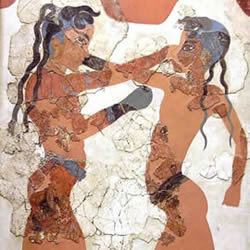
History Of Boxing
Early history
Minoan youths boxing, Akrotiri (Santorini) fresco. Earliest documented use of 'gloves'. See also Ancient Greek boxing
The earliest known depiction of boxing comes from a Sumerian relief from the 3rd millennium BC. Later depictions from the 2nd millennium BC are found in reliefs from the Mesopotamian nations of Assyria and Babylonia, and in Hittite art from Asia Minor. The earliest evidence for fist fighting with any kind of gloves can be found on Minoan Crete (c. 1500–900 BC), and on Sardinia, if we consider the boxing statues of Prama mountains (c. 2000–1000 BC).
Boxing was a popular spectator sport in Ancient Rome. In order for the fighters to protect themselves against their opponents they wrapped leather thongs around their fists. Eventually harder leather was used and the thong soon became a weapon. The Romans even introduced metal studs to the thongs to make the cestus which then led to a more sinister weapon called the myrmex (‘limb piercer’).
Fighting events were held at Roman Amphitheatres. The Roman form of boxing was often a fight until death to please the spectators who gathered at such events. However, especially in later times, purchased slaves and trained combat performers were valuable commodities, and their lives were not given up without due consideration. Often slaves were used against one another in a circle marked on the floor. This is where the term ring came from. In 393 AD, during the Roman gladiator period, boxing was abolished due to excessive brutality. It was not until the late 17th century that boxing re-surfaced in London.
Modern boxing
Broughton's rules (1743)
A straight right demonstrated in Edmund Price's The Science of Defense: A Treatise on Sparring and Wrestling, 1867
Records of Classical boxing activity disappeared after the fall of the Western Roman Empire when the wearing of weapons became common once again and interest in fighting with the fists waned. However, there are detailed records of various fist-fighting sports that were maintained in different cities and provinces of Italy between the 12th and 17th centuries. There was also a sport in ancient Rus called Kulachniy Boy or "Fist Fighting".
As the wearing of swords became less common, there was renewed interest in fencing with the fists. The sport would later resurface in England during the early 16th century in the form of bare-knuckle boxing sometimes referred to as prizefighting. The first documented account of a bare-knuckle fight in England appeared in 1681 in the London Protestant Mercury, and the first English bare-knuckle champion was James Figg in 1719. This is also the time when the word "boxing" first came to be used. It should be noted, that this earliest form of modern boxing was very different. Contests in Mr. Figg's time, in addition to fist fighting, also contained fencing and cudgeling. On 6 January 1681, the first recorded boxing match took place in Britain when Christopher Monck, 2nd Duke of Albemarle (and later Lieutenant Governor of Jamaica) engineered a bout between his butler and his butcher with the latter winning the prize.
Early fighting had no written rules. There were no weight divisions or round limits, and no referee. In general, it was extremely chaotic. The first boxing rules, called the Broughton's rules, were introduced by champion Jack Broughton in 1743 to protect fighters in the ring where deaths sometimes occurred. Under these rules, if a man went down and could not continue after a count of 30 seconds, the fight was over. Hitting a downed fighter and grasping below the waist were prohibited. Broughton also invented and encouraged the use of "mufflers", a form of padded gloves, which were used in training and exhibitions. The first paper on boxing was published in the early 1700s by a successful Cornish Wrestler from Bunnyip, Cornwall, named Sir Thomas Parkyns, who was also a Physics student of Sir Isaac Newton. The paper was actually a single page in his extensive Wrestling & Fencing manual that entailed a system of headbutting, punching, eye gouging, chokes, and hard throws not common in modern Boxing. Parkyns added the techniques described in his paper to his own fighting style.
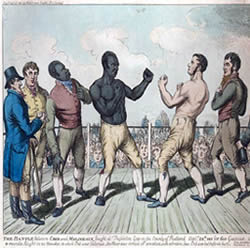
Tom Cribb vs Tom Molineaux in a re-match for the heavyweight championship of England, 1811
These rules did allow the fighters an advantage not enjoyed by today's boxers; they permitted the fighter to drop to one knee to begin a 30-second count at any time. Thus a fighter realizing he was in trouble had an opportunity to recover. However, this was considered "unmanly" and was frequently disallowed by additional rules negotiated by the Seconds of the Boxers. Intentionally going down in modern boxing will cause the recovering fighter to lose points in the scoring system. Furthermore, as the contestants did not have heavy leather gloves and wristwraps to protect their hands, they used different punching technique to preserve their hands because the head was a common target to hit full out as almost all period manuals have powerful straight punches with the whole body behind them to the face (including forehead) as the basic blows.
Marquess of Queensberry rules (1867)
In 1867, the Marquess of Queensberry rules were drafted by John Chambers for amateur championships held at Lillie Bridge in London for Lightweights, Middleweights and Heavyweights. The rules were published under the patronage of the Marquess of Queensberry, whose name has always been associated with them.
The June 1894 Leonard–Cushing bout. Each of the six one-minute rounds recorded by the Kinetograph was made available to exhibitors for $22.50. Customers who watched the final round saw Leonard score a knockdown. There were twelve rules in all, and they specified that fights should be "a fair stand-up boxing match" in a 24-foot-square or similar ring. Rounds were three minutes with one-minute rest intervals between rounds. Each fighter was given a ten-second count if he were knocked down, and wrestling was banned.
The introduction of gloves
The introduction of gloves of "fair-size" also changed the nature of the bouts. An average pair of boxing gloves resembles a bloated pair of mittens and are laced up around the wrists. The gloves can be used to block an opponent's blows. As a result of their introduction, bouts became longer and more strategic with greater importance attached to defensive maneuvers such as slipping, bobbing, countering and angling. Because less defensive emphasis was placed on the use of the forearms and more on the gloves, the classical forearms outwards, torso leaning back stance of the bare knuckle boxer was modified to a more modern stance in which the torso is tilted forward and the hands are held closer to the face.
Modern
Through the late nineteenth century, the martial art of boxing or prizefighting was primarily a sport of dubious legitimacy. Outlawed in England and much of the United States, prizefights were often held at gambling venues and broken up by police. Brawling and wrestling tactics continued, and riots at prizefights were common occurrences. Still, throughout this period, there arose some notable bare knuckle champions who developed fairly sophisticated fighting tactics.
The English case of R v. Coney in 1882 found that a bare-knuckle fight was an assault occasioning actual bodily harm, despite the consent of the participants. This marked the end of widespread public bare-knuckle contests in England.
The first world heavyweight champion under the Queensberry Rules was "Gentleman Jim" Corbett, who defeated John L. Sullivan in 1892 at the Pelican Athletic Club in New Orleans.
The first instance of film censorship in the United States occurred in 1897 when several states banned the showing of prize fighting films from the state of Nevada, where it was legal at the time.
Throughout the early twentieth century, boxers struggled to achieve legitimacy. They were aided by the influence of promoters like Tex Rickard and the popularity of great champions such as John L. Sullivan.
Rules
The Marquess of Queensberry rules have been the general rules governing modern boxing since their publication in 1867.
A boxing match typically consists of a determined number of three-minute rounds, a total of up to 12 rounds (formerly 15). A minute is typically spent between each round with the fighters in their assigned corners receiving advice and attention from their coach and staff. The fight is controlled by a referee who works within the ring to judge and control the conduct of the fighters, rule on their ability to fight safely, count knocked-down fighters, and rule on fouls.
Up to three judges are typically present at ringside to score the bout and assign points to the boxers, based on punches that connect, defense, knockdowns, and other, more subjective, measures. Because of the open-ended style of boxing judging, many fights have controversial results, in which one or both fighters believe they have been "robbed" or unfairly denied a victory. Each fighter has an assigned corner of the ring, where his or her coach, as well as one or more "seconds" may administer to the fighter at the beginning of the fight and between rounds. Each boxer enters into the ring from their assigned corners at the beginning of each round and must cease fighting and return to their corner at the signaled end of each round.
A bout in which the predetermined number of rounds passes is decided by the judges, and is said to "go the distance". The fighter with the higher score at the end of the fight is ruled the winner. With three judges, unanimous and split decisions are possible, as are draws. A boxer may win the bout before a decision is reached through a knock-out ; such bouts are said to have ended "inside the distance". If a fighter is knocked down during the fight, determined by whether the boxer touches the canvas floor of the ring with any part of their body other than the feet as a result of the opponent's punch and not a slip, as determined by the referee, the referee begins counting until the fighter returns to his or her feet and can continue.
Should the referee count to ten, then the knocked-down boxer is ruled "knocked out" (whether unconscious or not) and the other boxer is ruled the winner by knock-out (KO). A "technical knock-out" (TKO) is possible as well, and is ruled by the referee, fight doctor, or a fighter's corner if a fighter is unable to safely continue to fight, based upon injuries or being judged unable to effectively defend themselves. Many jurisdictions and sanctioning agencies also have a "three-knockdown rule", in which three knockdowns in a given round result in a TKO. A TKO is considered a knockout in a fighter's record. A "standing eight" count rule may also be in effect. This gives the referee the right to step in and administer a count of eight to a fighter that he feels may be in danger, even if no knockdown has taken place. After counting the referee will observe the fighter, and decide if he is fit to continue. For scoring purposes, a standing eight count is treated as a knockdown.
Ingemar Johansson of Sweden KO's heavyweight champion Floyd Patterson, 26 June 1959.
In general, boxers are prohibited from hitting below the belt, holding, tripping, pushing, biting, or spitting. The boxer's shorts are raised so the opponent is not allowed to hit to the groin area with intent to cause pain or injury. Failure to abide by the former may result in a foul. They also are prohibited from kicking, head-butting, or hitting with any part of the arm other than the knuckles of a closed fist (including hitting with the elbow, shoulder or forearm, as well as with open gloves, the wrist, the inside, back or side of the hand). They are prohibited as well from hitting the back, back of the neck or head (called a "rabbit-punch") or the kidneys. They are prohibited from holding the ropes for support when punching, holding an opponent while punching, or ducking below the belt of their opponent (dropping below the waist of your opponent, no matter the distance between).
If a "clinch" – a defensive move in which a boxer wraps his or her opponents arms and holds on to create a pause – is broken by the referee, each fighter must take a full step back before punching again (alternatively, the referee may direct the fighters to "punch out" of the clinch). When a boxer is knocked down, the other boxer must immediately cease fighting and move to the furthest neutral corner of the ring until the referee has either ruled a knockout or called for the fight to continue.
Violations of these rules may be ruled "fouls" by the referee, who may issue warnings, deduct points, or disqualify an offending boxer, causing an automatic loss, depending on the seriousness and intentionality of the foul. An intentional foul that causes injury that prevents a fight from continuing usually causes the boxer who committed it to be disqualified. A fighter who suffers an accidental low-blow may be given up to five minutes to recover, after which they may be ruled knocked out if they are unable to continue. Accidental fouls that cause injury ending a bout may lead to a "no contest" result, or else cause the fight to go to a decision if enough rounds (typically four or more, or at least three in a four-round fight) have passed.
Unheard of these days, but common during the early 20th Century in North America, a "newspaper decision (NWS)" might be made after a no decision bout had ended. A "no decision" bout occurred when, by law or by pre-arrangement of the fighters, if both boxers were still standing at the fight's conclusion and there was no knockout, no official decision was rendered and neither boxer was declared the winner. But this did not prevent the pool of ringside newspaper reporters from declaring a consensus result among themselves and printing a newspaper decision in their publications. Officially, however, a "no decision" bout resulted in neither boxer winning or losing. Boxing historians sometimes use these unofficial newspaper decisions in compiling fight records for illustrative purposes only. Often, media outlets covering a match will personally score the match, and post their scores as an independent sentence in their report.
Professional vs. amateur boxing
Throughout the 17th through 19th centuries, boxing bouts were motivated by money, as the fighters competed for prize money, promoters controlled the gate, and spectators bet on the result. The modern Olympic movement revived interest in amateur sports, and amateur boxing became an Olympic sport in 1908. In their current form, Olympic and other amateur bouts are typically limited to three or four rounds, scoring is computed by points based on the number of clean blows landed, regardless of impact, and fighters wear protective headgear, reducing the number of injuries, knockdowns, and knockouts. Currently scoring blows in amateur boxing are subjectively counted by ringside judges, but the Australian Institute for Sport has demonstrated a prototype of an Automated Boxing Scoring System, which introduces scoring objectivity, improves safety, and arguably makes the sport more interesting to spectators. Professional boxing remains by far the most popular form of the sport globally, though amateur boxing is dominant in Cuba and some former Soviet republics. For most fighters, an amateur career, especially at the Olympics, serves to develop skills and gain experience in preparation for a professional career.
Amateur boxing
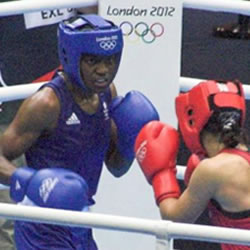
Nicola Adams is an Olympic gold medallist female boxer.
Amateur boxing may be found at the collegiate level, at the Olympic Games and Commonwealth Games, and in many other venues sanctioned by amateur boxing associations. Amateur boxing has a point scoring system that measures the number of clean blows landed rather than physical damage. Bouts consist of three rounds of three minutes in the Olympic and Commonwealth Games, and three rounds of three minutes in a national ABA (Amateur Boxing Association) bout, each with a one-minute interval between rounds.
Competitors wear protective headgear and gloves with a white strip or circle across the knuckle. A punch is considered a scoring punch only when the boxers connect with the white portion of the gloves. Each punch that lands cleanly on the head or torso with sufficient force is awarded a point. A referee monitors the fight to ensure that competitors use only legal blows. A belt worn over the torso represents the lower limit of punches – any boxer repeatedly landing low blows below the belt is disqualified. Referees also ensure that the boxers don't use holding tactics to prevent the opponent from swinging. If this occurs, the referee separates the opponents and orders them to continue boxing. Repeated holding can result in a boxer being penalized or ultimately disqualified. Referees will stop the bout if a boxer is seriously injured, if one boxer is significantly dominating the other or if the score is severely imbalanced. Amateur bouts which end this way may be noted as "RSC" (referee stopped contest) with notations for an outclassed opponent (RSCO), outscored opponent (RSCOS), injury (RSCI) or head injury (RSCH).
Professional boxing
Firpo sending Dempsey outside the ring; painting by George Bellows.
Professional bouts are usually much longer than amateur bouts, typically ranging from ten to twelve rounds, though four round fights are common for less experienced fighters or club fighters. There are also some two- and three-round professional bouts, especially in Australia. Through the early twentieth century, it was common for fights to have unlimited rounds, ending only when one fighter quit, benefiting high-energy fighters like Jack Dempsey. Fifteen rounds remained the internationally recognized limit for championship fights for most of the twentieth century until the early 1980s, when the death of boxer Duk Koo Kim eventually prompted the World Boxing Council and other organizations sanctioning professional boxing to reduce the limit to twelve rounds.
Headgear is not permitted in professional bouts, and boxers are generally allowed to take much more damage before a fight is halted. At any time, however, the referee may stop the contest if he believes that one participant cannot defend himself due to injury. In that case, the other participant is awarded a technical knockout win. A technical knockout would also be awarded if a fighter lands a punch that opens a cut on the opponent, and the opponent is later deemed not fit to continue by a doctor because of the cut. For this reason, fighters often employ cutmen, whose job is to treat cuts between rounds so that the boxer is able to continue despite the cut. If a boxer simply quits fighting, or if his corner stops the fight, then the winning boxer is also awarded a technical knockout victory. In contrast with amateur boxing, professional male boxers have to be bare chested.
Boxing styles
Definition of style
"Style" is often defined as the strategic approach a fighter takes during a bout. No two fighters' styles are alike, as it is determined by that individual's physical and mental attributes. There are three main styles in boxing: out-fighter ("boxer"), brawler (or "slugger"), and In-fighter ("swarmer"). These styles may be divided into several special subgroups, such as counter puncher, etc. The main philosophy of the styles is, that each style has an advantage over one, but disadvantage over the other one. It follows the rock-paper-scissors scenario - boxer beats brawler, swarmer beats boxer, and brawler beats swarmer.
Boxer/out-fighter
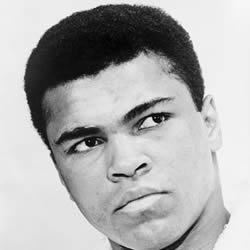
Heavyweight champion Muhammad Ali is a typical example of an out-fighter.
A classic "boxer" or stylist (also known as an "out-fighter") seeks to maintain distance between himself and his opponent, fighting with faster, longer range punches, most notably the jab, and gradually wearing his opponent down. Due to this reliance on weaker punches, out-fighters tend to win by point decisions rather than by knockout, though some out-fighters have notable knockout records. They are often regarded as the best boxing strategists due to their ability to control the pace of the fight and lead their opponent, methodically wearing him down and exhibiting more skill and finesse than a brawler. Out-fighters need reach, hand speed, reflexes, and footwork. Notable out-fighters include Muhammad Ali, Larry Holmes, Joe Calzaghe, Floyd Mayweather Jr., Wilfredo Gómez, Salvador Sanchez, Cecilia Brækhus, Gene Tunney, Ezzard Charles, Willie Pep, Meldrick Taylor, Ricardo Lopez, Roy Jones, Jr., and Sugar Ray Leonard. This style was also used by fictional boxer Apollo Creed.
Boxer-puncher
A boxer-puncher is a well-rounded boxer who is able to fight at close range with a combination of technique and power, often with the ability to knock opponents out with a combination and in some instances a single shot. Their movement and tactics are similar to that of an out-fighter (although they are generally not as mobile as an out-fighter), but instead of winning by decision, they tend to wear their opponents down using combinations and then move in to score the knockout. A boxer must be well rounded to be effective using this style.
Notable boxer-punchers include Manny Pacquiao, Wladimir Klitschko, Lennox Lewis, Joe Louis, Wilfredo Gómez, Oscar de la Hoya, Archie Moore, Miguel Cotto, Nonito Donaire, Sam Langford, Henry Armstrong, Sugar Ray Robinson, Tony Zale, Carlos Monzón, Alexis Argüello, Erik Morales, Terry Norris, Marco Antonio Barrera, Naseem Hamed, Thomas Hearns and Victor Ortiz.
Counter puncher
Counter punchers are slippery, defensive style fighters who often rely on their opponent's mistakes in order to gain the advantage, whether it be on the score cards or more preferably a knockout. They use their well-rounded defense to avoid or block shots and then immediately catch the opponent off guard with a well placed and timed punch. A fight with a skilled counter-puncher can turn into a war of attrition, where each shot landed is a battle in itself. Thus, fighting against counter punchers requires constant feinting and the ability to avoid telegraphing ones attacks. To be truly successful using this style they must have good reflexes, a high level of prediction and awareness, pinpoint accuracy and speed, both in striking and in footwork.
Notable counter punchers include Vitali Klitschko, Floyd Mayweather, Jr., Evander Holyfield, Max Schmeling, Chris Byrd, Jim Corbett, Jack Johnson, Bernard Hopkins, Laszlo Papp, Jerry Quarry, Anselmo Moreno, James Toney, Marvin Hagler, Juan Manuel Márquez, Humberto Soto, Roger Mayweather, Pernell Whitaker and Sergio Gabriel Martinez.
Counter punchers usually wear their opponents down by causing them to miss their punches. The more the opponent misses, the faster they'll tire, and the psychological effects of being unable to land a hit will start to sink in. The counter puncher often tries to outplay their opponent entirely, not just in a physical sense, but also in a mental and emotional sense. This style can be incredibly difficult, especially against seasoned fighters, but winning a fight without getting hit is often worth the pay-off. They usually try to stay away from the center of the ring, in order to outmaneuver and chip away at their opponents. A large advantage in counter-hitting is the forward momentum of the attacker, which drives them further into your return strike. As such, knockouts are more common than one would expect from a defensive style.
Brawler/slugger
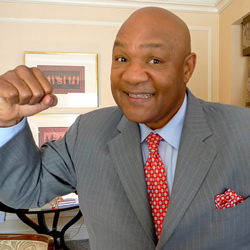
Famous brawler George Foreman
A brawler is a fighter who generally lacks finesse and footwork in the ring, but makes up for it through sheer punching power. Mainly Irish, Irish-American, Puerto Rican, Mexican, and Mexican-American boxers popularized this style. Many brawlers tend to lack mobility, preferring a less mobile, more stable platform and have difficulty pursuing fighters who are fast on their feet. They may also have a tendency to ignore combination punching in favour of continuous beat-downs with one hand and by throwing slower, more powerful single punches (such as hooks and uppercuts). Their slowness and predictable punching pattern (single punches with obvious leads) often leaves them open to counter punches, so successful brawlers must be able to absorb substantial amounts of punishment. However not all brawler/slugger fighters are not mobile, some can move around and switch styles if needed but still have the brawler/slugger style such as Wilfredo Gómez, Prince Naseem Hamed and Danny García.
A brawler's most important assets are power and chin (the ability to absorb punishment while remaining able to continue boxing). Examples of this style include George Foreman, Danny García, Wilfredo Gómez, Sonny Liston, John L. Sullivan, Max Baer, Prince Naseem Hamed, Ray Mancini, David Tua, Arturo Gatti, Micky Ward, Michael Katsidis, James Kirkland, Marcos Maidana, Jake Lamotta, Manny Pacquiao, and Ireland's John Duddy. This style of boxing was also used by fictional boxers Rocky Balboa and James "Clubber" Lang.
Brawlers tend to be more predictable and easy to hit but usually fare well enough against other fighting styles because they train to take punches very well. They often have a higher chance than other fighting styles to score a knockout against their opponents because they focus on landing big, powerful hits, instead of smaller, faster attacks. Oftentimes they place focus on training on their upper body instead of their entire body, to increase power and endurance. They also aim to intimidate their opponents because of their power, stature and ability to take a punch.
Swarmer/in-fighter
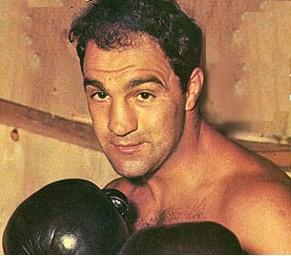
Undefeated heavyweight champion Rocky Marciano was an excellent swarmer and in-fighter but also had the power of a brawler.
In-fighters/swarmers (sometimes called "pressure fighters") attempt to stay close to an opponent, throwing intense flurries and combinations of hooks and uppercuts. A successful in-fighter often needs a good "chin" because swarming usually involves being hit with many jabs before they can maneuver inside where they are more effective. In-fighters operate best at close range because they are generally shorter and have less reach than their opponents and thus are more effective at a short distance where the longer arms of their opponents make punching awkward. However, several fighters tall for their division have been relatively adept at in-fighting as well as out-fighting.
The essence of a swarmer is non-stop aggression. Many short in-fighters utilize their stature to their advantage, employing a bob-and-weave defense by bending at the waist to slip underneath or to the sides of incoming punches. Unlike blocking, causing an opponent to miss a punch disrupts his balance, permits forward movement past the opponent's extended arm and keeps the hands free to counter. A distinct advantage that in-fighters have is when throwing uppercuts where they can channel their entire bodyweight behind the punch; Mike Tyson was famous for throwing devastating uppercuts. Marvin Hagler was known for his hard "chin", punching power, body attack and the stalking of his opponents. Some in-fighters, like Mike Tyson, have been known for being notoriously hard to hit. The key to a swarmer is aggression, endurance, chin, and bobbing-and-weaving.
Notable in-fighters include Julio César Chávez, Miguel Cotto, Joe Frazier, Danny García, Mike Tyson, Manny Pacquiao, Saúl Álvarez, Rocky Marciano, Jack Dempsey, Wayne McCullough, Harry Greb, David Tua and Ricky Hatton.
Combinations of styles
All fighters have primary skills with which they feel most comfortable, but truly elite fighters are often able to incorporate auxiliary styles when presented with a particular challenge. For example, an out-fighter will sometimes plant his feet and counter punch, or a slugger may have the stamina to pressure fight with his power punches.
Style matchups
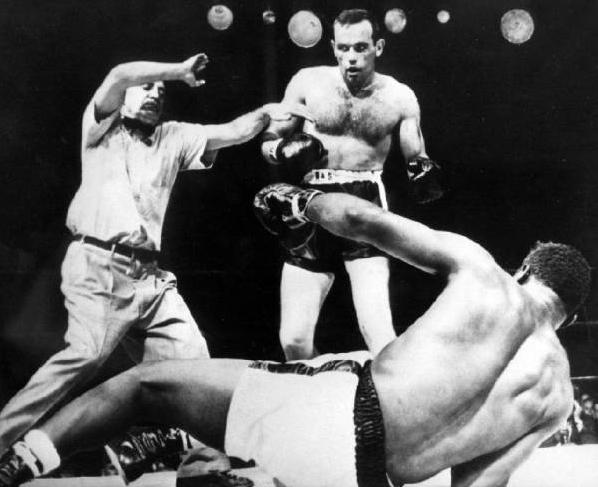
Louis vs. Schmeling, 1936
There is a generally accepted rule of thumb about the success each of these boxing styles has against the others. In general, an in-fighter has an advantage over an out-fighter, an out-fighter has an advantage over a brawler, and a brawler has an advantage over an in-fighter; these form a cycle with each style being stronger relative to one, and weaker relative to another, with none dominating, as in rock-paper-scissors. Naturally, many other factors, such as the skill level and training of the combatants, determine the outcome of a fight, but the widely held belief in this relationship among the styles is embodied in the cliché amongst boxing fans and writers that "styles make fights."
Brawlers tend to overcome swarmers or in-fighters because, in trying to get close to the slugger, the in-fighter will invariably have to walk straight into the guns of the much harder-hitting brawler, so, unless the former has a very good chin and the latter's stamina is poor, the brawler's superior power will carry the day. A famous example of this type of match-up advantage would be George Foreman's knockout victory over Joe Frazier in their original bout "The Sunshine Showdown".
Although in-fighters struggle against heavy sluggers, they typically enjoy more success against out-fighters or boxers. Out-fighters prefer a slower fight, with some distance between themselves and the opponent. The in-fighter tries to close that gap and unleash furious flurries. On the inside, the out-fighter loses a lot of his combat effectiveness, because he cannot throw the hard punches. The in-fighter is generally successful in this case, due to his intensity in advancing on his opponent and his good agility, which makes him difficult to evade. For example, the swarming Joe Frazier, though easily dominated by the slugger George Foreman, was able to create many more problems for the boxer Muhammad Ali in their three fights. Joe Louis, after retirement, admitted that he hated being crowded, and that swarmers like untied/undefeated champ Rocky Marciano would have caused him style problems even in his prime.
The boxer or out-fighter tends to be most successful against a brawler, whose slow speed (both hand and foot) and poor technique makes him an easy target to hit for the faster out-fighter. The out-fighter's main concern is to stay alert, as the brawler only needs to land one good punch to finish the fight. If the out-fighter can avoid those power punches, he can often wear the brawler down with fast jabs, tiring him out. If he is successful enough, he may even apply extra pressure in the later rounds in an attempt to achieve a knockout. Most classic boxers, such as Muhammad Ali, enjoyed their best successes against sluggers.
An example of a style matchup was the historical fight of Julio César Chávez, a swarmer or in-fighter, against Meldrick Taylor, the boxer or out-fighter (see Julio César Chávez vs. Meldrick Taylor). The match was nicknamed "Thunder Meets Lightning" as an allusion to punching power of Chávez and blinding speed of Taylor. Chávez was the epitome of the "Mexican" style of boxing. Taylor's hand and foot speed and boxing abilities gave him the early advantage, allowing him to begin building a large lead on points. Chávez remained relentless in his pursuit of Taylor and due to his greater punching power Chávez slowly punished Taylor. Coming into the later rounds, Taylor was bleeding from the mouth, his entire face was swollen, the bones around his eye socket had been broken, he had swallowed a considerable amount of his own blood, and as he grew tired, Taylor was increasingly forced into exchanging blows with Chávez, which only gave Chávez a greater chance to cause damage.
While there was little doubt that Taylor had solidly won the first three quarters of the fight, the question at hand was whether he would survive the final quarter. Going into the final round, Taylor held a secure lead on the scorecards of two of the three judges. Chávez would have to knock Taylor out to claim a victory, whereas Taylor merely needed to stay away from the Mexican legend. However, Taylor did not stay away, but continued to trade blows with Chávez. As he did so, Taylor showed signs of extreme exhaustion, and every tick of the clock brought Taylor closer to victory unless Chávez could knock him out. With about a minute left in the round, Chávez hit Taylor squarely with several hard punches and stayed on the attack, continuing to hit Taylor with well-placed shots.
Finally
Finally, with about 25 seconds to go, Chávez landed a hard right hand that caused Taylor to stagger forward towards a corner, forcing Chávez back ahead of him. Suddenly Chávez stepped around Taylor, positioning him so that Taylor was trapped in the corner, with no way to escape from Chávez' desperate final flurry. Chávez then nailed Taylor with a tremendous right hand that dropped the younger man. By using the ring ropes to pull himself up, Taylor managed to return to his feet and was given the mandatory 8-count. Referee Richard Steele asked Taylor twice if he was able to continue fighting, but Taylor failed to answer. Steele then concluded that Taylor was unfit to continue and signaled that he was ending the fight, resulting in a TKO victory for Chávez with only two seconds to go in the bout.
Equipment
Since boxing involves forceful, repetitive punching, precautions must be taken to prevent damage to bones in the hand. Most trainers do not allow boxers to train and spar without wrist wraps and boxing gloves. Hand wraps are used to secure the bones in the hand, and the gloves are used to protect the hands from blunt injury, allowing boxers to throw punches with more force than if they did not utilize them. Gloves have been required in competition since the late nineteenth century, though modern boxing gloves are much heavier than those worn by early twentieth-century fighters. Prior to a bout, both boxers agree upon the weight of gloves to be used in the bout, with the understanding that lighter gloves allow heavy punchers to inflict more damage. The brand of gloves can also affect the impact of punches, so this too is usually stipulated before a bout.
A mouth guard is important to protect the teeth and gums from injury, and to cushion the jaw, resulting in a decreased chance of knockout. Both fighters must wear soft soled shoes to reduce the damage from accidental (or intentional) stepping on feet. While older boxing boots more commonly resembled those of a professional wrestler, modern boxing shoes and boots tend to be quite similar to their amateur wrestling counterparts.
Boxers practice their skills on two basic types of punching bags. A small, tear-drop-shaped "speed bag" is used to hone reflexes and repetitive punching skills, while a large cylindrical "heavy bag" filled with sand, a synthetic substitute, or water is used to practice power punching and body blows. In addition to these distinctive pieces of equipment, boxers also utilize sport-nonspecific training equipment to build strength, speed, agility, and stamina. Common training equipment includes free weights, rowing machines, jump rope, and medicine balls.
Boxing matches typically take place in a boxing ring, a raised platform surrounded by ropes attached to posts rising in each corner. The term "ring" has come to be used as a metaphor for many aspects of prize fighting in general.